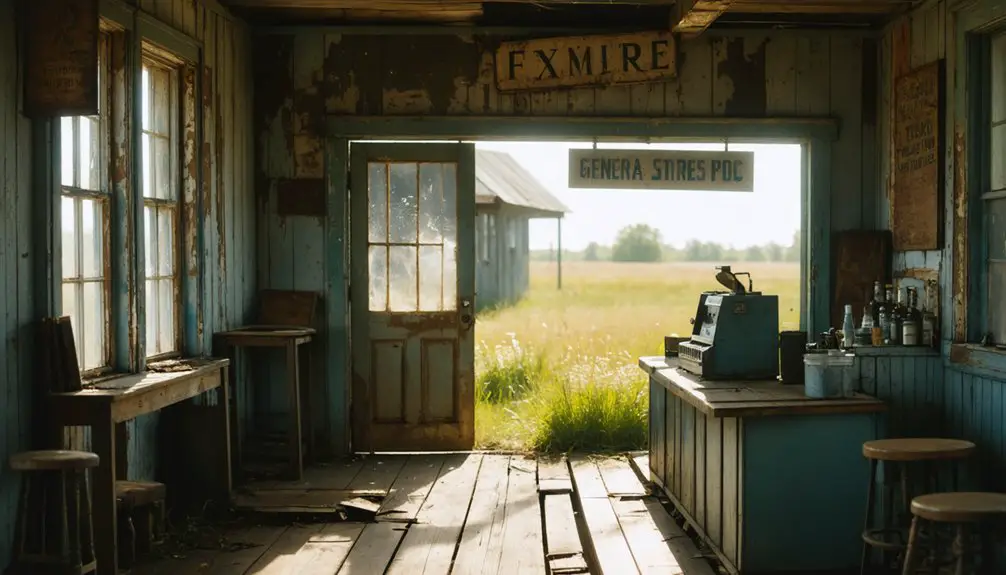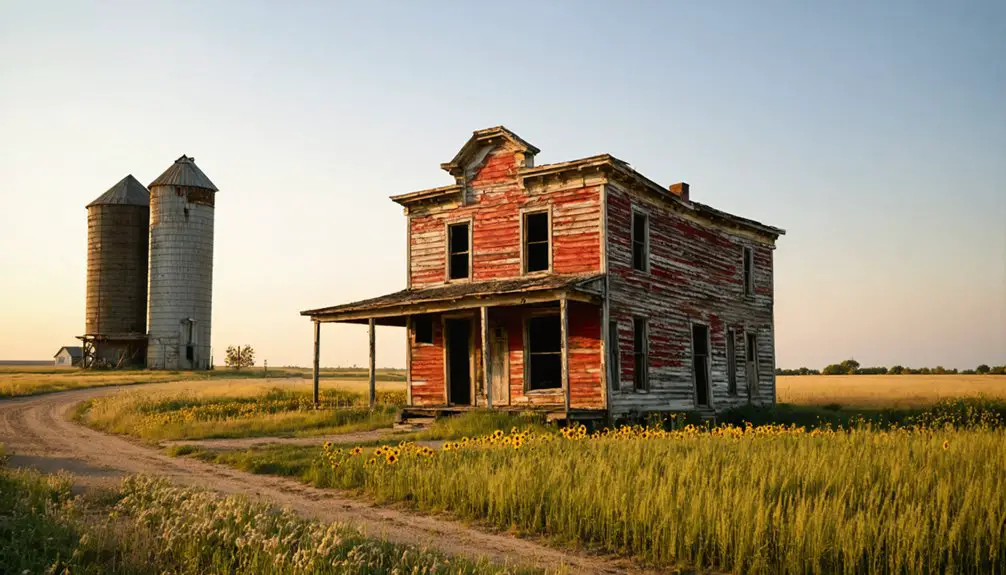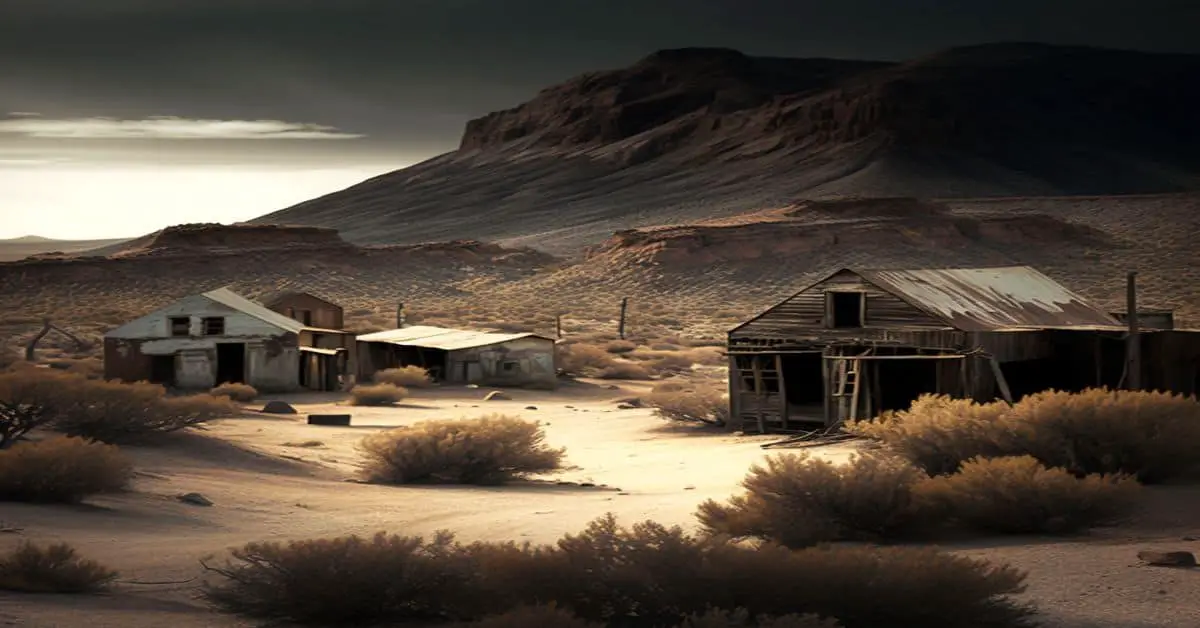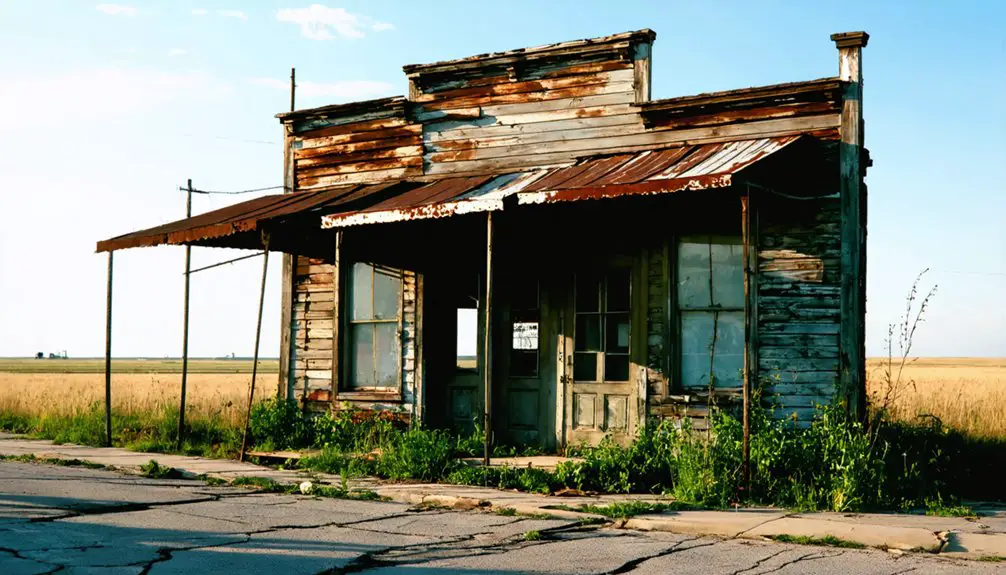You’ll find Savannah, Nebraska’s most intriguing ghost town, in Butler County, where it served as the first county seat from 1868 to 1873. Founded by David R. Gardner in 1859, this frontier settlement once boasted a courthouse, hotel, and thriving community along Skull Creek. After losing its county seat status to David City in 1873, Savannah’s buildings were dismantled rather than relocated. Today, six original structures and the historic cemetery offer glimpses into this vanished pioneer town’s fascinating past.
Key Takeaways
- Savannah, a ghost town in Butler County, Nebraska, was established in 1859 and served as the county’s first county seat until 1873.
- The town’s decline began after losing county seat status to David City through an election in March 1873.
- Physical remnants include six original dwellings, a railroad depot, church building, and an active cemetery containing over 610 graves.
- Business owners dismantled buildings rather than relocating after the town’s decline, contributing to Savannah’s transformation into a ghost town.
- The town’s legacy continues through Savannah Township’s name and historical records maintained by local societies and courthouse documents.
The Birth of a Frontier Settlement
When Butler County was officially established by the Nebraska Territorial Legislature in 1856, it marked the beginning of organized settlement in this frontier region.
The establishment of Butler County in 1856 launched a new chapter of pioneer settlement in Nebraska’s untamed frontier lands.
You’ll find that the county’s name likely honors William Orlando Butler, a Mexican-American War general who’d declined the Nebraska Territory governorship in 1854.
The frontier challenges faced by early settlers shaped the county’s settlement dynamics. While over 50 prospective towns were envisioned, only 13 survived the harsh realities of frontier life. Similar to other Butler County locations across America, the area faced significant development hurdles during its early years.
Savannah, founded by David R. Gardner in 1859, emerged as the county’s first settlement, while Mahala City’s brief existence in 1858 exemplified the era’s volatility.
You’d have encountered isolated homesteaders, resource scarcity, and primitive infrastructure, including ferry crossings managed by pioneers like S. D. Shinn.
The early territory was initially dominated by cattle ranchers from 1858 to 1868, before farmers began arriving in significant numbers.
Life in Early Savannah
As settlers established themselves in early Savannah, the community’s lifeblood centered around Skull Creek and the Platte River tributaries. You’d have found a bustling frontier town between 1869 and 1872, where the courthouse and hotel stood as symbols of civilization amid pioneer challenges.
While indigenous groups like the Pawnee had largely moved on, their legacy remained in scattered artifacts and pottery. The Shinn’s Ferry crossing, established in 1858, became a vital transportation link for the region.
You’d have witnessed merchants running general stores and grain dealers conducting business, while blacksmiths’ hammers rang out across the settlement. David R. Gardner’s ferry service kept commerce flowing across the river.
The town’s strategic location near wooded hills provided shelter and building materials for the growing community. Life revolved around cooperative survival, with settlers sharing resources and gathering for court sessions and local councils. The area’s rich soil composition of dark clayey earth supported the growing agricultural activities of early residents.
Political Power and County Seat Status
You’ll discover that Savannah’s status as Butler County’s first county seat ended abruptly with the March 1873 election that transferred power to the newly created David City.
When Mrs. Phoebe Davids Miles donated land for the new county seat that May, she set in motion a dramatic shift in the region’s political center of gravity.
The first Commissioner meeting was held at Bone Creek Schoolhouse in October 1868, establishing Savannah’s early role in county governance.
The loss of county seat status triggered an exodus from Savannah, as government functions, businesses, and residents relocated to David City, leaving Savannah to fade into obscurity. The county would continue to grow, reaching a population of 8,400 by 2010, though Savannah remained only a memory of its former prominence.
County Seat Power Shift
The political landscape of Butler County underwent significant transformation through its early county seat designations, beginning with Savannah’s selection as the first county seat in 1868.
You’ll find that county seat dynamics shifted dramatically when David City emerged as a contender, leading to a decisive election in March 1873 that moved the seat from Savannah.
This power shift reflected broader population shifts within the region, as David City’s central location proved more accessible to the county’s growing settlements.
The move was further solidified when Mrs. Phoebe Davids Miles donated land for the courthouse.
The town’s establishment as county seat was quickly followed by the town site survey in May 1873.
You can trace the impact of this relocation in the area’s development patterns – while David City flourished as the new administrative center, Savannah gradually declined into ghost town status, marking a permanent change in Butler County’s political geography.
Election Sparks Town Exodus
While Savannah initially prospered as Butler County’s first county seat from 1868, its destiny changed dramatically after the pivotal 1873 election transferred power to David City. The election impact triggered a swift town decline as residents and merchants raced to protect their livelihoods by relocating to the new seat of power.
Much like how fire shapes savannas, natural and political forces worked to transform the landscape of Butler County. You can trace the exodus through these key developments:
- Business owners dismantled their buildings rather than starting fresh.
- The post office, established just three years earlier, lost its significance.
- Administrative jobs and legal services shifted to David City, pulling the economic base away.
This political power shift effectively sealed Savannah’s fate, as the community couldn’t survive without its county seat status. Fountain H. Angle opened the first general store in David City in 1873, signaling the beginning of the new county seat’s commercial growth. The town faded into history, leaving only its township name as a reminder.
The Great Migration to David City
During the 1840s, Nebraska’s vast untamed prairies beckoned settlers westward as part of a significant migration movement that would eventually lead to David City’s establishment.
You’ll find that European immigrants, particularly Germans and Czechs, faced numerous challenges as they sought agricultural opportunities through the Homestead Act of 1862.
They’d left behind crowded European lands and political upheaval for the promise of personal freedom and land ownership. Many settlers formed close-knit communities that maintained their cultural traditions and religious practices for generations.
Legacy of a Vanished Community

You’ll find Butler County’s ghost town legacy preserved through meticulous historical records, maintained by local historical societies that document the stories of vanished communities like Savannah.
The physical remnants of these lost towns can still be seen in old cemetery sites, township boundaries, and archived county records from the 1800s.
The community’s pioneer spirit lives on through genealogical collections, courthouse documents, and oral histories passed down through generations of Butler County residents.
Historical Records Preserve Memory
The preservation of Butler’s history endures through meticulous documentation spanning over 150 years.
You’ll find genealogical connections through Butler County’s extensive records, maintained without disruption since territorial days. The courthouse in David City safeguards essential records that trace the community’s archival preservation from 1856 onward.
When exploring Butler’s past, you’ll discover:
- Marriage licenses dating to 1869, birth and death records from 1904, and census data from 1854
- Land transactions and probate records documenting early settler patterns
- Church registries and cemetery records on platforms like Findagrave, linking descendants to their pioneer roots
The Nebraska Historic Resources Survey Initiative continues to document Butler’s legacy, ensuring future generations can connect with their heritage through these carefully preserved records.
Physical Remnants Still Visible
Today’s visitors to Butler can still witness tangible evidence of this once-thriving community through several remaining structures and historical landmarks.
You’ll find six original dwellings, including a two-story railroad depot and barn, while the Christian Church building stands as a monument to its 225-person congregation.
The relocated District One Schoolhouse preserves educational heritage, and the Dawson grain elevator remains visible along the railroad tracks.
The memorial landscapes include an active cemetery north of the former church, containing over 610 souls and serving as a genealogical treasure.
You can trace Butler’s footprint through abandoned railroad infrastructure, including the “Y” junction and historic crossings.
While agricultural fields now cover much of the town site, the rolling hills and natural features continue to frame these physical structures that mark Butler’s legacy.
Community Stories Live On
While Butler’s physical structures continue to weather time, its rich legacy endures through vibrant community stories and meticulous historical documentation.
You’ll find the town’s memory preservation efforts alive through local historical societies and genealogical records that capture the spirit of early settlers.
Community identity remains strong through:
- Active storytelling by historians like Steve Schmid who share detailed accounts of frontier life
- Preserved oral histories and personal anecdotes passed down through generations
- Cemetery documentation and family records that maintain connections to original settlers
The cultural fabric of Butler lives on through township names and commemorative events.
You can access these stories through county archives, historical presentations, and family histories that paint a vivid picture of pioneer resilience and community adaptation.
Archaeological Remnants and Historical Sites
Archaeological investigations throughout Butler County reveal a rich tapestry of both Native American and early settler history, with three significant sites standing out: the Bellwood site near Savannah, Barcal site near Lynwood, and Lynwood site itself.
You’ll find evidence of long-term indigenous habitation through permanent village remains that predate white settlement, highlighting the archaeological significance of the region.
Today, you can explore physical remnants including building foundations, grain elevator sites, and visible ruts from the historic Ox-Bow Trail near Brainard.
The Mormon Trail and Shinn’s Ferry locations offer glimpses into early transportation routes that shaped settlement patterns.
The Butler County Museum & Historical Society preserves these stories through artifacts and documents, while the 2017 Historic Resources Survey helps protect these irreplaceable links to the past.
Preserving Savannah’s Memory
As Butler County’s first county seat in 1868, Savannah’s legacy lives on through a rich tapestry of oral histories, documented records, and community preservation efforts.
You’ll find the ghost town’s memory preservation sustained through local storytelling and historical society programs.
While physical structures have long since relocated to David City, you can explore Savannah’s heritage through:
- Post office records from 1870-1882 that document the town’s operations
- Land transaction archives maintained by the county clerk
- Cemetery records preserved by regional genealogical societies
Today, you’ll discover Savannah’s name lives on in Savannah Township, while Butler County Cultural initiatives continue sharing its story through exhibits and presentations, ensuring this pioneering settlement’s significance isn’t forgotten in Nebraska’s history.
Frequently Asked Questions
What Native Tribes Originally Inhabited the Savannah Area Before Settlement?
You’ll find the Paleo-Indians were first, followed by Creek (Muscogee), Cherokee, and Yamacraw tribes in the Savannah area, though the area differs from the Omaha Tribe and Pawnee Nation territories.
Were There Any Notable Crimes or Lawlessness Reported in Savannah?
You won’t find specific crime rates for Savannah, as historical records don’t document notable lawlessness there. While Butler County faced cattle rustling issues, law enforcement records don’t highlight unique criminal activity in Savannah.
What Happened to the Cemetery and Burial Grounds of Savannah?
You’ll find limited evidence of cemetery preservation in Savannah’s burial grounds today. After the town’s abandonment, these sacred sites likely deteriorated, with many graves possibly relocated to nearby active church cemeteries.
Did Any Famous Pioneers or Historical Figures Visit Savannah?
Presently preserved records show no famous pioneers or historical figures visited Savannah during its brief existence. You won’t find documented proof of any notable personalities passing through this short-lived settlement.
What Natural Disasters or Epidemics Affected Savannah During Its Existence?
You won’t find documented flood damage or disease outbreaks in Savannah’s history. While the town sat near the Platte River and faced typical frontier health risks, no disasters directly impacted it.
References
- https://en.wikipedia.org/wiki/Savannah
- https://www.youtube.com/watch?v=RODvVi84tLk
- https://nsgs.org/cpage.php?pt=48
- https://en.wikipedia.org/wiki/Butler_County
- http://www.kancoll.org/books/andreas_ne/butler/butler-p4.html
- https://www.butlernemuseum.com/history
- https://www.youtube.com/watch?v=xCbFN_yLFrk
- http://genealogytrails.com/neb/butler/earlyhistory.htm
- http://www.kancoll.org/books/andreas_ne/butler/butler-p1.html
- http://www.kancoll.org/books/andreas_ne/butler/butler-p7.html



